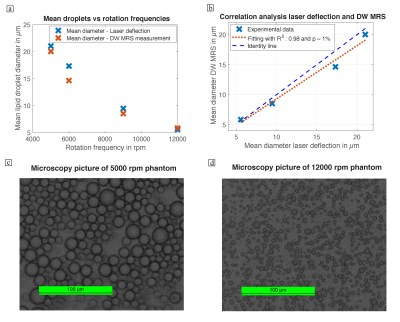MRS of Lipids & Fatty Acids
MRS of Lipids & Fatty Acids
Combined Educational & Scientific Session
Combined Educational & Scientific Session
ORGANIZERS: Catherine Hines, Ronald Ouwerkerk
Tuesday, 14 May 2019
| Room 512A-H | 08:15 - 10:15 | Moderators: Naranamangalam Jagannathan, Kyu-Ho Song |
Skill Level: Basic to Intermediate
Session Number: TU-02
Overview
This course will provide insight in the role of lipids in cancer metabolism and explain how MR-visible lipids can provide insight in the microenvironment of tumor cells and how this can be used for cancer diagnosis and the monitoring of treatment response in animal models and in humans. The second lecture will focus on 1H and 13C MRS methods to quantify lipid content and characterize lipid compositions and how this can help understand fatty acid metabolism and its role in a variety of diseases.
Target Audience
MR scientists, MR technologists, clinicians, and scientists interested in performing MR spectroscopy studies to investigate metabolic processes in oncology and other diseases or developing related methodologies.
Educational Objectives
As a result of attending this course, participants should be able to:
- Identify what lipids are visible with MR;
- Explain how lipid metabolism is linked (micro)environmental factors such as inflammation, acidity, and oxygen in tumors;
- Describe changes that may occur in the MR visible lipids, the development of cancer, in apoptosis, and in successful therapy;
- Name a number of 13C and 1H-MRS techniques to quantify and characterize lipids in-vivo;
- Recognize lipid metabolism and its link to metabolic switches, redox state; and
- Describe what MRS observation of lipid content or composition can reveal about metabolic state and metabolic diseases.
Overview
This course will provide insight in the role of lipids in cancer metabolism and explain how MR-visible lipids can provide insight in the microenvironment of tumor cells and how this can be used for cancer diagnosis and the monitoring of treatment response in animal models and in humans. The second lecture will focus on 1H and 13C MRS methods to quantify lipid content and characterize lipid compositions and how this can help understand fatty acid metabolism and its role in a variety of diseases.
Target Audience
MR scientists, MR technologists, clinicians, and scientists interested in performing MR spectroscopy studies to investigate metabolic processes in oncology and other diseases or developing related methodologies.
Educational Objectives
As a result of attending this course, participants should be able to:
- Identify what lipids are visible with MR;
- Explain how lipid metabolism is linked (micro)environmental factors such as inflammation, acidity, and oxygen in tumors;
- Describe changes that may occur in the MR visible lipids, the development of cancer, in apoptosis, and in successful therapy;
- Name a number of 13C and 1H-MRS techniques to quantify and characterize lipids in-vivo;
- Recognize lipid metabolism and its link to metabolic switches, redox state; and
- Describe what MRS observation of lipid content or composition can reveal about metabolic state and metabolic diseases.
| 08:15 |
|
MRS of Lipids & Fatty Acids: Metabolism, Composition & Quantification
Corin Miller
Lipids are a large class of biomolecules naturally occurring in different forms throughout the body. As many lipid species tend to exist in high concentrations, they are an abundant source of MR-observable nuclei. This presentation will review the measurements of lipids that have been made successfully with MRS-based approaches and highlight the important findings from MRS studies of lipids. Specifically, focus will be on the following areas: (1) Introduction to characteristics of lipids, (2) Detection and quantification of lipid levels with 1H MRS, (3) Assessment of lipid composition with 1H MRS and 13C MRS too, (4) Measurement of the kinetics of lipid metabolism with 13C MRS.
|
08:45 |
0372.  |
Fat-fraction provides classification and treatment response assessment of metastatic lymph nodes for patients with radio-recurrent prostate cancer
Olusola Adeleke, Arash Latifoltojar, Harbir Sidhu, Manil Chouhan, Athar Haroon, Asim Afaq, Reena Davda, Heather Payne, Hashim Ahmed, Shonit Punwani
Lesion size threshold is the most common imaging feature used to assess response to therapy. Size as an imaging feature has its limitations. Quantitative imaging biomarkers (QIBs) could identify subtle microstructural changes prior to morphological changes. In this study, we explored the use of novel whole-body MRI (WB-MRI) QIBs for nodal disease characterisation and treatment response monitoring in radio-recurrent prostate cancer (rPC). We showed signal fat fraction could discriminate between positive and negative nodes and that it can be used for response monitoring.
|
| 09:05 |
|
MRS of Lipids & Fatty Acids: Relevance in Cancer
E. Jim Delikatny
|
09:35 |
0373.  |
Measuring large lipid droplet sizes by probing restricted lipid diffusion effects with Diffusion-Weighted Magnetic Resonance Spectroscopy at 3 T
Dominik Weidlich, Julius Honecker, Oliver Gmach, MingMing Wu, Rainer Burgkart, Stefan Ruschke, Daniela Franz, Bjoern Menze, Thomas Skurk, Hans Hauner, Ulrich Kulozik, Dimitrios Karampinos
Despite its strong relevance in metabolism, non-invasive measurement of adipocyte size remains an unmet need. High b-value DW-MRS has been previously applied to probe diffusion restriction effects of intramyocellular lipids or brown adipocytes using preclinical systems with strong gradient systems. However, probing diffusion restriction in large lipid droplets on a clinical system remains a major challenge. The present work proposes a methodology to probe lipid droplet sizes with high b-value long diffusion time DW-MRS. The method was examined with simulations, validated in phantoms and tested to estimate bone marrow adipocyte size in the tibia of healthy subjects.
|
| 09:55 |
0374.  |
Musculoskeletal Lipid Compartments Separation and Quantification by High-Resolution Metabolite Cycling Magnetic Resonance Spectroscopic Imaging at 3 T
Ahmad Alhulail, Pingyu Xia, Xiaopeng Zhou, M. Albert Thomas, Ulrike Dydak, Uzay Emir
A fast and high-resolution density-weighted concentric ring trajectory metabolite cycling MRSI sequence was implemented to generate simultaneous lipid- and water-only spectra within a short scan time (~3 min) at 3T, and compared to Dixon MRI. LCModel was used to fit the peaks of intramyocellular and extramyocellular lipids that were used to generate separate high-resolution maps for each of these lipid compartments. In addition, the proposed MRSI sequence showed higher sensitivity by sampling lipids at areas that Dixon failed to detect any lipid signal.
|
| 10:15 |
|
Adjournment |
 Back to Program-at-a-Glance |
Back to Program-at-a-Glance |  Back to Top
Back to Top